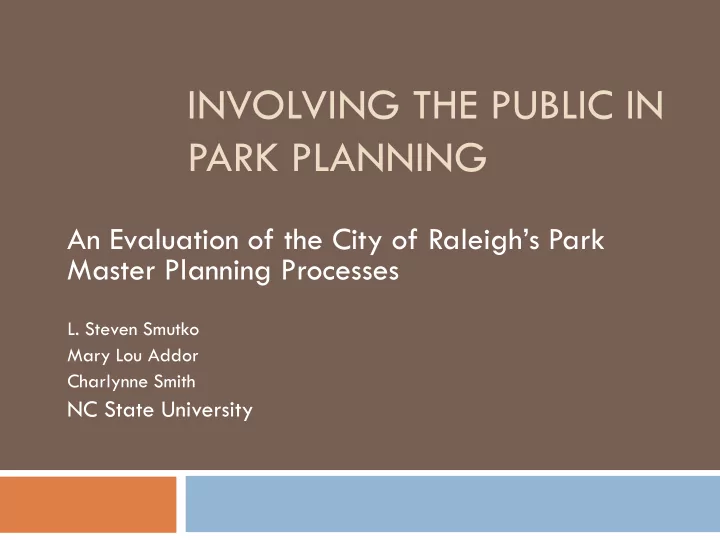

INVOLVING THE PUBLIC IN PARK PLANNING An Evaluation of the City of Raleigh’s Park Master Planning Processes L. Steven Smutko Mary Lou Addor Charlynne Smith NC State University
Purpose of Study To assess how, to what degree and to what end citizens participate in decisions regarding the scope and character of park sites. Specifically How, to what degree, and in what form the opinions, needs, and desires of citizens were included in final park designs that resulted from both processes. How well citizens understood the process and how their opinions, needs, and desires were factored into the final design.
Two Processes, Four Parks Processes: Parks Planning Committee (Resolution Process) Core Team (Community Meeting Process) Parks: Forest Ridge Park (Resolution Process) Horseshoe Farm Park (Resolution Process) Leesville Park (Community Meeting) Timberlake Park (Community Meeting)
Interviews and Surveys Raleigh Parks Department Staff Raleigh Parks Recreation and Greenway Advisory Board members Park planning committees Citizens attending park planning meetings Park planning consultants
Evaluation Criteria Quality Decisions that (1) identify the values, interests, and concerns of all who are interested in or affected by the planning decision; (2) use the best available knowledge, and (3) incorporate new information, methods, and concerns that arise over time. Legitimacy Process is seen by the public as fair and competent and follows governing laws and regulations.
Evaluation Criteria Capacity Participants, including Department staff and consultants, (1) become better informed and more skilled at effective participation; (2) become better able to engage the best available knowledge and information about diverse values, interests, and concerns; and (3) develop a more widely shared understanding of the issues and decision challenges and a “reservoir of communication skills, mediation skills, and mutual trust.”
Outcomes Both processes produced quality planning from the perspective of the public involved Process legitimacy was the most problematic of all three practice outcomes for both planning processes. Community Meeting Process: lack of community-wide participation and transparency Resolution Process: problems stemmed from issues of leadership and process management. Both processes, when done well, can create capacity for future decisions.
General Recommendations Adhere to core principles 1. Manage processes effectively 2. Develop a broad public involvement policy 3. Engage citizens in comprehensive planning and 4. system integration planning Establish clear definitions of appropriate park 5. elements and programs Decouple planning for controversial elements from 6. planning for the park
General Recommendations Gather data on potential park uses and users 7. before engaging in planning Improve communication mechanisms including use 8. of the internet Use consultants with proven public participation 9. skills 10. Evaluate every public participation process 11. Maintain process flexibility
Recommendations Specific to the Community Meeting Process Diversify meeting promotion methods to increase 1. participation Be clear up front about program constraints and 2. priority program elements Add community members to the core team 3. Provide handouts of the planning process 4. Establish communication links with meeting participants 5. Provide clear and timely meeting summaries 6. Increase the venues through which people can 7. participate
Recommendations Specific to the Resolution Process Improve criteria for committee selection 1. Develop a process charter and ground rules 2. Encourage openness of design 3. Use a consensus decision rule 4. Use a neutral facilitator 5. Train the committee in principled negotiation 6.
Recommend
More recommend